#Mold inlay design
Text
Causes and Countermeasures for Deformation of Injection Molded Parts - 7
Serial No. 7 (Friends who are interested can follow Gud Mould to view previous series in historical news)
3) Mold inlay design
Usually when moldmakers consider inlay design, their starting points are: ease of processing, lower material costs, reduce tendency of mold core deformation, and improve exhaust. However, few mold designers can proactively consider mold core inlays from perspective of…

View On WordPress
#Causes and countermeasures for deformation of injection molded parts#clamping force#cooling design#Deformation of Injection Molded Parts#design of exhaust#Exhaust system design#injection molded parts#injection molding production#injection pressure#Mold designer#Mold ejection design#mold factories#Mold inlay design#mold manufacturing#product design#Strength of mold structure
0 notes
Text
Enhancing the Beauty and Functionality of Your Space With Wooden Skirting

Wooden skirting is a versatile decorative element that offers many practical benefits to your home. From covering up imperfections to protecting floors, floor wooden skirting adds polish and creates an upscale appearance for any space in which it is placed.
As well as hiding cables and wiring, sound-dampening panels also conceal cables while improving thermal insulation and sound-dampening properties. They can easily be painted or stained to fit in with your design aesthetic and decor scheme.
The Role of Wooden Skirting
Skirting boards contributed from wood are mandatory for each room because they perform both purpose and aesthetics to the room. Similarly, skirting boards also function as a shield against furniture, vehicle, and foot traffic damaging walls beneath them, hence preventing scratches and dents on the walls as well as dust deposition between walls and floor surface, which would have resulted in unsightliness of the rooms!
The wooden skirting that incorporates skirting of your floors is a simple, effortless, and convenient option for you to get your dream floor and take care of the utilitarian features like managing cables in your homes and offices. The good news is that it's also extremely functional. As such, lace would be an excellent addition to your decor!
When it comes to the skirting boards, you can also apply finishing wood behind the staircase to make it blend or you can use other materials to create a cohesive aesthetic around the home. Skirts from Georgian or Victorian designs to the modes of the modern era are equally possible and everywhere you go, they should always match the mood of the place.
You may also read :- Custom made sofa
Choosing the Right Skirting
Dural and stain-proof furniture is advisable if you have smaller kids and pets since toys can break furniture and some accidental marks can stain your furniture. Hence, the furniture should have some kind of protection for it. This safeguards them from scratches, marks, or chips in the process, hence, protecting them from further damaging the pierced surfaces.
Additionally, decorative molding profiles can be utilized to improve the visual attributes and the overall aesthetic of your skirting and to make it even more special and diverse. Among the various options, complex inlays usually end up being the most eye-catching artifacts that show the culture you were born in, hobbies, or things that represent you.
Installation
Floor skirting may seem like an insignificant architectural feature, but its importance cannot be understated in enhancing the visual aesthetics of your space. By concealing gaps and imperfections along the transition between walls and floors, floor wooden skirting adds visual interest while giving your interior space a finished and polished appearance.
Careful selection of wood species that matches or contrasts with your floor stain, considering room style preferences, pre-finished options available to you, quality materials used in its production as well as craftsmanship are key factors in creating skirting.
Maintenance
Wooden floor skirting may appear minor, but it plays a vital role in any interior design scheme. Not only can it conceal unsightly gaps and transitions more smoothly between rooms but it can also tie your interior together stylishly.
Maintaining wooden floor skirting is simple thanks to its durability and low maintenance requirements. All that's required to keep it looking like new is occasional dusting and wiping; any accidental spills should be cleaned up promptly as moisture can cause irreparable damage or warping if left behind.
Summary
Wooden skirting comes in an assortment of designs and finishes to meet any decor style or room design, giving you the power to craft a custom look to complement your decor. Explore different molding profiles like crown molding, dentil molding and picture rail molding to add visual interest and architectural appeal. Decorative inlays or carvings add personality and charm to the room as well.
Read extra:- Wall to wall carpet in Dubai
2 notes
·
View notes
Text

Graceful Prince
The name for this fig is 翩翩太子, piānpiān tàizǐ, which translates (according to machine translation) as graceful / elegant prince.
The name becomes quite beautifully clear when we see the inspiration:
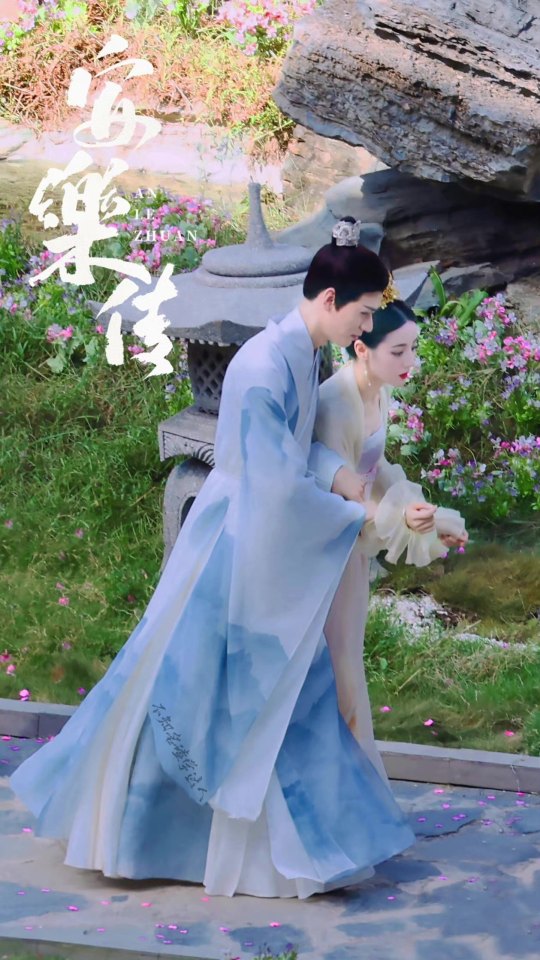
All of Gong Jun's costumes as Prince Han Ye are absolutely gorgeous, and this one is no exception. I can't wait to see this costume (and all the others!) in the show. It's nice to have these figs tiding us over in the interim!

Knock on wood and fingers crossed, I've been getting really lucky with figs coming in perfect condition (at least when I don't forget to have them air wrapped!).
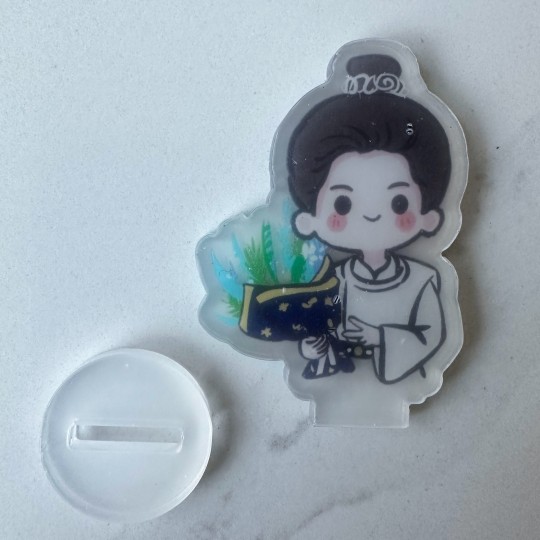
One of the options we had was to purchase an additional standee. It's standard policy here at Figthusiast Central to buy all the extras and add-ons, so here it is! It's not peeled (the translucent protective film over it is still on both sides) so it's not as bright and colorful as it will be. This is not the fig art, but instead art of the wrap up of filming:

He's a very elegant prince indeed!

The fig maker did a lovely job with the faint flush in his cheeks, and of course, my absolute favorite sideways smile.

I wish I had more photos of this costume so we could compare it against all sides, but this will be a good preview of it! It's so airy and ethereal in the still photo.
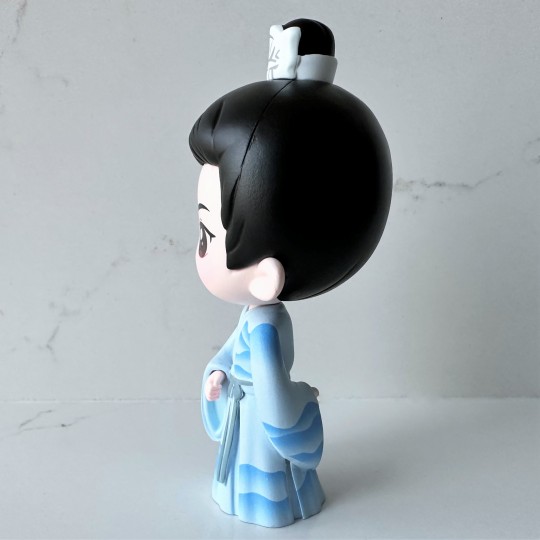
The modeling on his hand that he's holding in front of him is very detailed and beautiful - you can see every single finger. That's no roughly designed blob!
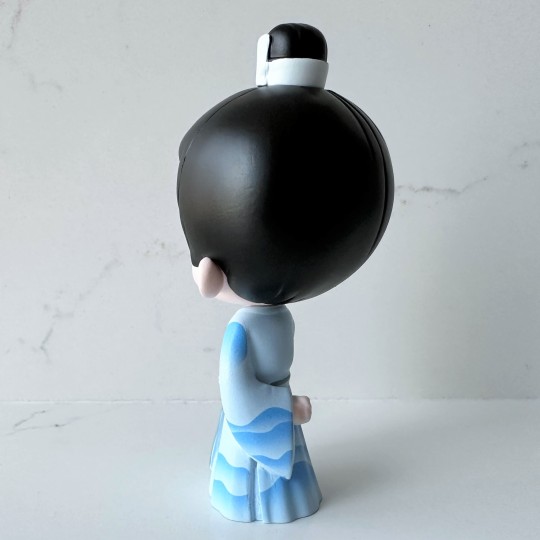
Hahaha, ok, this hand looks like a roughly designed blob! But that's just the angle. We'll keep going!
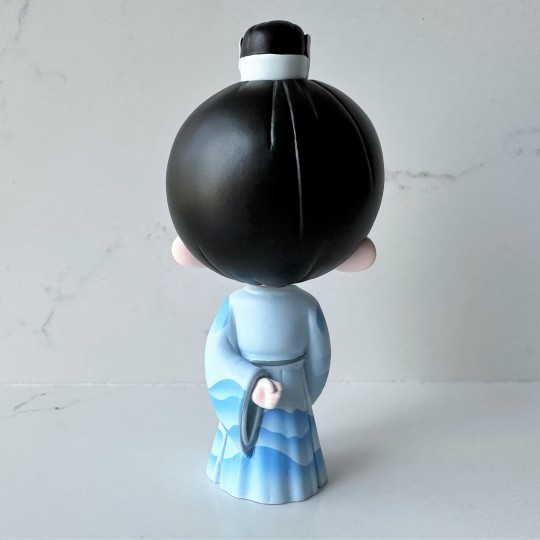
Ah this hanfu is so beautiful. I like how the fig maker designed the folds to emphasize the pattern of the misty mountains.
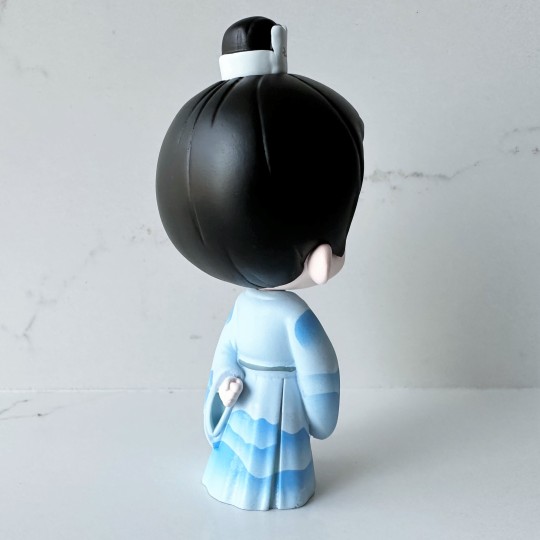
There's a little more detail on the back hand - it's difficult as the light from my window (on the left of the fig) is kind of washing the detail out. It does also have nice molding on it.

Ah you can really see the folds of the hanfu here - I get the sense the fig is walking. Slowly and elegantly, of course. I always have a special place in my heart for what I think of as this Wen Kexing posture.

And here we're coming around again to the front! More of that great sense of gentle walking motion.

No robe or pants/boots detail here! Just a clean solid block of resin.
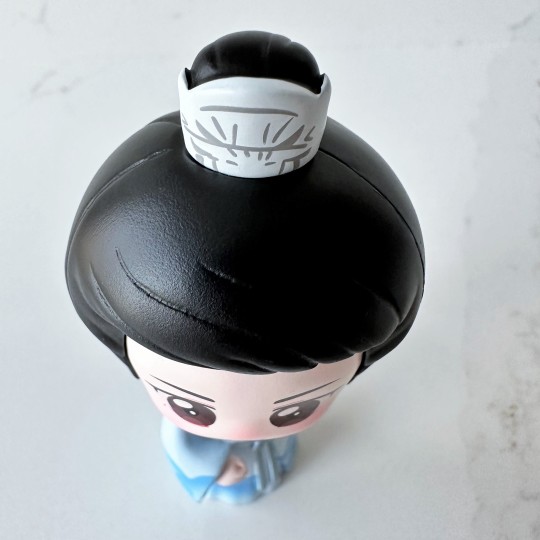
A nice shot of his guan here. I zoomed in to take a look at the original in the photo, and what I could tell of it (which is not a ton) it looks VERY complex. Almost like some some mother of pearl or some other shimmery type of inlay in a very intricate crown. So as much as I would like to see the fig maker replicate it, I can understand why it's better sometimes to just not get too crazy and in over your head (haha, I didn't mean that pun!).
Alright, I promised a close up of the hand, didn't I!
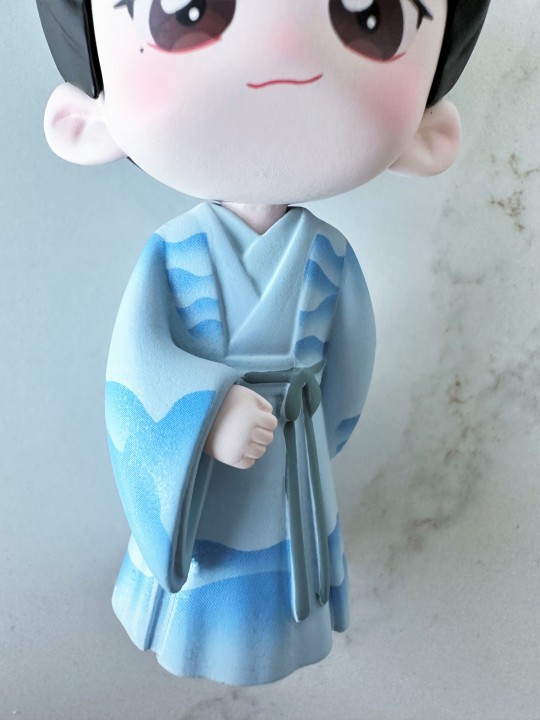
Here we have the extreme close up of the front...

....and ok, this is a little less detailed on the back! I'm pleased to see my camera did not wash it out with the sunshine as much as I thought. Still, looks good, especially for a hand that won't be seen much, if at all, inside my fig display.
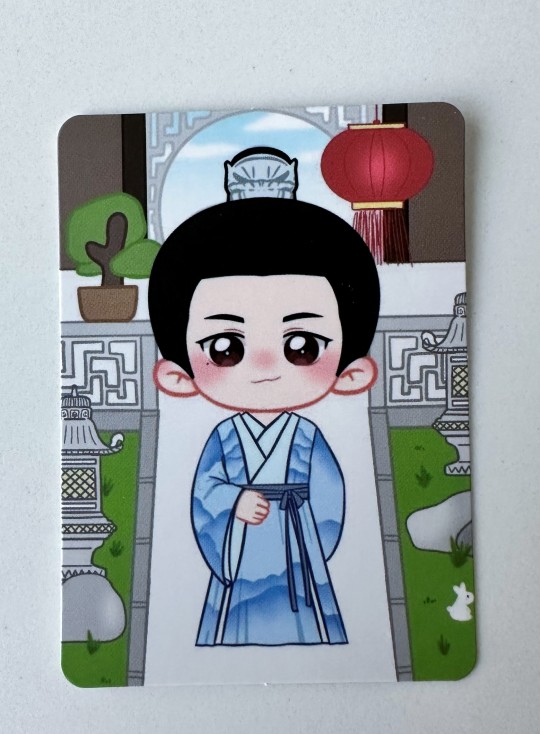

The fig came inside a plain white box, but the box card is quite nice. This seller always has this style of card where there's art on one side and a three-side view of the fig on the other. You can see the name of the fig, 翩翩太子, on the top of the card.
Material: Resin
Fig Count: 234
Scene Count: 18
Rating: Graceful and elegant indeed!
[link back to Master Fig Index for more posts]
#gong jun#legend of anle#legend of anle merch#an le zhuan#han ye#prince han ye#shl cast#word of honor cast#figthusiast#jzeu
8 notes
·
View notes
Text
The Pueblo Jewelers of the Southwest

In the world of Pueblo artisans, the jewelry makers are second in number to the pottery makers. Over the generations, this ancient craft has taken on numerous forms. On the meticulous end of the spectrum, there are those who make tiny beads, called heishi, first produced at today's Santo Domingo (Kewa) Pueblo in prehistoric times, with hand-pump drills and stone drill bits, and then strung as necklaces. From there, Pueblo jewelry runs from semi-precious stones set in silver to contemporary works, made with gold and precious gemstones. In between are tufa-castings (a process using a carved volcanic stone as a mold for molten silver or gold); hammered metal; handmade silver beads; choruses of tiny bird effigies carved from stone and strung; classic concho belts; large seashells covered in mosaic stonework; and some of the most prized lapidary work in the world, famously done by Zuni Pueblo artists. There are works in stainless steel cut to a fine edge, "shadow boxes" (where a design is cut out of a sheet of burnished silver, which is then affixed to an underlying piece of blackened silver, thereby creating an image in negative space), as well as bracelets, rings, bolo ties, and belt buckles, all worn today by design-savvy buyers from around the world.
Steve LaRance, of Hopi and Assiniboine heritage, gets his tufa on the Hopi Reservation from deposits created by the San Francisco Peaks. To gather what he needs, he has to drive a four-wheel drive pickup, find an isolated spot, and spend a day digging with shovels and picks. The tufa comes out in chunks, in sizes that range from bowling ball to suitcase. This will generally provide enough raw material for a year's work.
Steve and his wife and jewelry-making partner, Marian Denipah, moved from Arizona some years back to Marian's homelands, just a stone's throw from the lazy Rio Grande on Ohkay Owingeh land in northern New Mexico. In addition to their various lines of jewelry, they have also produced a batch of children and grandchildren that have made marks of their own. One daughter is a physician; another, along with her brother, spent a decade as principal dancers for Cirque du Soleil. Today, Steve and Marian oversee a Native youth dance troupe called the Lightning Boy Foundation, which travels the world in an effort to spread Pueblo values and skills.
Santo Domingo is one of the Rio Grande Pueblos in Northern New Mexico. For centuries the Pueblo people have been mining turquoise at Cerrillos, south of what is now Santa Fe, and have been acquiring other turquoise from as far away as Nevada, California and Colorado.
The Pueblo jewelers traveled south to the Gulf and west to the Pacific for shell when they couldn't trade for it. Jet and red colored rock was found nearby and used in mosaics and other jewelry. Eventually coral was introduced by the Spanish and replaced the red rock. These colorful stones were made into beads and mosaics for decoration and ceremonies.
The people of Santo Domingo became known for making the best disc beads and, along with the Zuni people, for producing the best inlay in turquoise, jet, shell and coral on shell and wood bases. The jewelers of Santo Domingo still produce the finest handmade beads and mosaics. Many of their children acquire drills and learn to make beads at a very young age. You can shop online for authentic Pueblo jewelry at PuebloDirect.com.
5 notes
·
View notes
Text
A Peek Inside the Opulent Coconut Palace
By: Pauline Yumul
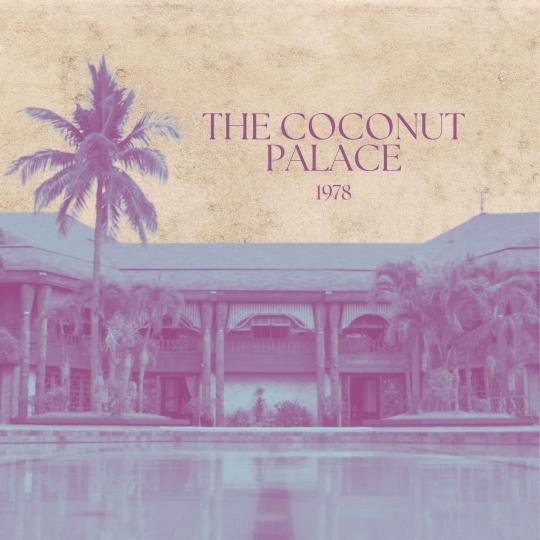
Commissioned by former First Lady Imelda Marcos, who is well known for her shoe collection and passion for luxurious living, as well as being the wife of former President Ferdinand Marcos. The Coconut Palace was erected in 1978 to accommodate Pope John Paul II for his 1981 visit to the nation. The Pope, on the other hand, correctly declined to stay in this luxurious residence while visiting a poor country after learning that it cost the Filipino citizens ₱37,000,000 roughly equal to the worth Purchasing Power Value of ₱670,000,000 in 2022. His refusal was a well-publicized protest against the Marcoses, who lived extravagantly while millions of Filipinos lived in abject poverty.
The Coconut Palace is also known as “Tahanang Pilipino”, which was believed to be like no other home that has ever been built. It has a truly unique construction with an unusual architectural style. All parts of the coconut (roots, trunk, leaves, fruits, shells, bark, and even blossoms) are reflected in the palace's architecture. A design of interconnecting hexagons and half hexagons in a honeycomb pattern was planned. The hexagon was chosen as the unifying design element by accident: when stitched for planks, a coconut tree trunk is first formed into a six-sided column. Fresh coconut is opened similarly by cutting the husk along six sides. In any event, the recurring hexagonal forms within and beyond the Tahanang Pilipino's spaces offer a feeling of organic coherence. The hexagon is replicated and echoed in the inlay pattern on the marble flooring, the shape of the swimming pool, the twin stairs that go from the main floor to the higher rooms, and the many subtle features of the interior.
On a grand scale, the Tahanang Pilipino derives from the Bahay na Bato ancestral home, it has a ground floor of stone and an upper floor of wood. However, a creative reconfiguration of the family home's characteristic design forms, as well as its primary principle of "space surrounded by space," transforms it into an entirely contemporary interpretation. The six-sided domed double roof of coconut wood shingles, shaped like a salakot, or farmer's gourd hat, is the most striking external feature. A set of paired columns, which are inverted coconut trunks with a unique bulge at the root end producing capital, support, and balance the mass of the roof. With its high ceiling, sumptuous decorations, and dramatic interplay of light and shadow, the great entry hall accentuates the vast grandeur of the Tahanan. The main dining hall is also an elongated hexagon that opens on one side to the front garden and on the other to a receiving room.
From the entry hall, a collection of hexagonal rooms that make up the living room, music room, library, and a second reception room extend. The use of glass doors, antesalas, and landings create continuity between areas that are reminiscent of the family home. Overall, the interiors represent the Filipino's nearly Baroque taste, with their love of adornment, elaboration, and enrichment. Grand chandeliers made of coconut shells and crystal beads create dramatic centerpieces in the foyer and main halls, but the minor elements, such as cornices, moldings, inlays, and filigrees, have received equal care.
Before being the official residence of the country's vice president, it served as a guest house for celebrities such as Brooke Shields and George Hamilton. It has also appeared on television series such as The Amazing Race and Tanging Yaman. The palace also hosted wedding receptions. In 2011, Jejomar Binay was given it as his official office and house as Vice President of the Republic of the Philippines. While it is meant to reflect the Filipino people's ingenuity and tenacity, as well as the nation's cherished coconut tree, the objective for its creation and the identities of those involved do not resonate well with the Filipino people. The Coconut Palace has undoubtedly heard many secrets of the Marcos government since it has sheltered world dignitaries, cronies, and the often-elusive visitors who avoid media scrutiny. If walls could talk, they would undoubtedly reveal the many unanswered catastrophes under Martial Law.
Sources:
Buildeee. (2022). The Coconut Palace (2022 Public Visits Update). Buildeee.com. Retrieved 21 September 2022, from https://buildeee.com/articles/the-coconut-palace.
Coconut Palace MAÑOSA & COMPANY. Manosa.com. (2022). Retrieved 21 September 2022, from http://www.manosa.com/~manosa/teddy/project.php?/architecture/residential/coconut-palace-ccp-complex-pasay-city/&id=3#.
Esquire. (2020). Retrieved 21 September 2022, from https://www.esquiremag.ph/long-reads/features/inside-the-famed-coconut-palace-a00293-20200422-lfrm.
SunStar. (2016). The Coconut Palace. SUNSTAR. Retrieved 21 September 2022, from https://www.sunstar.com.ph/article/83902/the-coconut-palace.
The Coconut Palace. Planet of Hotels. (2022). Retrieved 21 September 2022, from https://planetofhotels.com/guide/en/philippines/manila/coconut-palace.
16 notes
·
View notes
Text
What Services Can a Cosmetic Dentist in Woodbridge Provide?

Cosmetic dentistry is a branch that provides appearance-enhancing treatment to effectively alter a patient's anterior teeth, gums, and lips. It depends more on beautifying the teeth and smile than on a detailed diagnosis and treatment of tooth diseases. Cosmetic dentists utilize different therapies and techniques to feast discoloration, misaligned or uneven teeth, cracks, and chipped teeth.
Teeth Whitening
A cosmetic procedure offered by a Cosmetic Dentist in Woodbridge that is among the most requested and readily available is teeth whitening or bleaching. This procedure entails mechanical techniques involving using reagents to change the color of the teeth by diet, smoking, drugs, aging, and brackets. Teeth whitening requires bleach materials and may be done either in the dental office or at home using trays from the dentist's mold of the patient's teeth by the dentist.
Dental Veneers
These are thin laminates designed to fit on the anterior part of the tooth. It is commonly constructed from porcelain ceramic or composite material and is fitted to alter several dental deformities: chipped, cracked, stained, or crooked teeth. Veneers are affixed uniquely on the teeth' surface to achieve a natural and appealing look. The process entails shaving off a section of the outer surface of the tooth's enamel to accommodate the work meant to be done on the veneer. This guarantees a perfect fit and appearance that is as close to the natural teeth as possible.
Dental Implants
There are various advantages to choosing dental implants: The restored teeth look natural, and they are a long-term solution for replacing lost teeth. Essentially, they feature a titanium post set into the jawbone as a tooth root replacement for the missing tooth. As soon as the implant is connected to the bone, the Cosmetic dentist in Stafford installs a crown that is specially designed for the space that has been left empty.
Dental Bonding
Dental bonding involves placing tooth-colored material directly on the teeth to fix minor problems like roughly placed chips, breaks, and spaces. The material is positioned in the patient's jaws and managed into the tooth's form; the material sets with the help of a particular light. It is an easy and affordable approach that helps enrich the teeth' look, and it usually takes a short time, within a day, to be conducted.
Inlays and Onlays
These are different forms of restoration used when the tooth's destruction is not severe enough to qualify for a crown. An inlay is fitted in the cavity smaller than the pulp chamber, and it sits within the tooth's cusps, whereas an onlay is over one or more cusps of the tooth. Inlay and onlay are custom-made indirect restorations made from either porcelain or composite resin material, which are very strong and resistant to staining or wear. These are appropriately contoured to the tooth's shape and developed to ensure a perfect and long-lasting solution to the problem.
Orthodontics
In orthodontics, it is widely known as part of general dentistry; however, Cosmetic dentist in Lorton practice orthodontic procedures to reposition and enhance the look of the teeth. These consist of conventional braces or orthodontic trays (for example, Invisalign) for tackling rotated, crowded, overlapping, protruding, deep bite, and open bite teeth. It can be noted that clear aligners are the most sought-after orthodontic appliances because of their ability to work discreetly. Made from clear plastic, these aligners are individualized and worn over the teeth to gradually realign them throughout treatment, making them easier to wear and more discrete than ordinary metal braces.
Gum Contouring
Gum contouring, also understood as gum reshaping or tissue sculpting, is a cosmetic dental practice that concerns reshaping the gum line to enhance the formation of the teeth and smile. This practice often handles issues such as a "gummy" smile, where excessive gum tissue is visible, or even an irregular gum line. Gum contouring can be conducted utilizing a scalpel, laser, or radiofrequency, with lasers being the preferred method due to their precision and minimal discomfort.
Smile Makeovers
A smile makeover is a complete method to enhance the smile's overall appearance through a combination of cosmetic dental procedures. This personalized treatment plan is tailored to the individual's specific needs and goals, addressing multiple aspects of the smile, such as color, alignment, shape, and size of the teeth. A smile makeover may contain teeth whitening, veneers, dental bonding, orthodontics, and gum contouring.
Dental Crowns
Dental crowns, or caps, reform damaged or decayed teeth' shape, size, potency, and formation. A crown is a custom-made, tooth-shaped covering that wraps the entire visual part of the tooth above the gum line. Crowns are generally made from porcelain, ceramic, or metal, with porcelain and ceramic being the preferred choices for their natural appearance.
Dental Bridges
Dental bridges substitute one or more lost teeth by bridging the void between the remaining teeth. A bridge consists of one or more unnatural teeth (pontics) anchored by crowns on adjacent natural teeth or dental implants. Bridges can be constructed from different materials, including porcelain, ceramic, and metal, with porcelain being the most popular choice for its natural look.
0 notes
Text
Mosaic Floor Tile Ideas for Every Room in Your Home

Tired of traditional floor tiles? Craving a touch of personality and unique style in your home? Look no further than the captivating world of mosaic floor tiles! These tiny tesserae, meticulously arranged in dazzling patterns and captivating colors, offer endless possibilities to transform any room into a visual masterpiece.
But with so many options available, where do you even begin? Fear not, design enthusiasts! This guide will equip you with the inspiration and information you need to find the perfect mosaic floor tiles for every room in your home.
Mosaic Floor Tiles: A Boon for Every Space
Before diving into specific rooms, let's explore the inherent advantages of mosaic floor tiles that make them a compelling choice for your entire home:
Durability Underfoot
Made from a variety of materials like ceramic, glass, or even natural stone, mosaic tiles are incredibly durable. They can withstand high traffic and resist scratches, chips, and cracks, making them ideal for busy areas like hallways, kitchens, and bathrooms.
Easy Maintenance Champions
The small size of mosaic tiles minimizes grout lines, which are notorious for dirt and grime build-up. Regular cleaning with a damp mop is all it takes to keep your mosaic floors sparkling clean.
Moisture Resistant Champs
Bathrooms and kitchens are naturally humid environments. Mosaic tiles, unlike some natural stone options, are highly resistant to moisture, minimizing the risk of mold and mildew growth.
Endless Design Possibilities
This is where mosaic tiles truly shine! With a vast array of colors, patterns, and textures available, you can create a unique and personalized look for any room. From classic geometric patterns to intricate floral motifs and playful modern designs, the possibilities are endless.
Mosaic Floor Tile Magic: Room by Room
Now, let's get specific and explore how mosaic floor tiles can elevate each room in your home:
Entryway Elegance
Make a lasting first impression with a stunning mosaic tile entryway. Opt for a geometric pattern in bold colors to create a vibrant welcome. You can even incorporate a personal touch by using a mosaic tile inlay with your family's initials or a welcoming message.
Kitchen Flair
Mosaic tiles can add a touch of personality and functionality to your kitchen. Consider using them for a backsplash behind your sink or stovetop for a splash of color and easy cleaning. Mosaic floor tiles in a neutral color scheme can add visual interest without overwhelming the space.
Bathroom Bliss
Transform your bathroom into a spa-like retreat with mosaic floor tiles. Pebble mosaic tiles offer a gentle massage underfoot, while shimmering glass mosaic tiles in calming blues or greens create a serene atmosphere. You can even create a decorative border around your bathtub or shower for a touch of luxury.
Living Room Luxury
Mosaic floor tiles can add a touch of sophistication to your living room. Opt for a classic herringbone pattern in a timeless color scheme for a touch of elegance. For a more modern approach, consider a bold geometric pattern in contrasting colors to create a statement piece.
Bedroom Tranquility
Mosaic floor tiles can even find a place in your bedroom haven. Opt for smaller, smoother mosaic tiles in calming neutral tones to create a sense of peace and relaxation. You can even create a decorative mosaic tile border around your bed for a touch of visual interest.
A Final Note: Unleash Your Creativity!
Mosaic floor tiles are an invitation to unleash your inner designer. Explore the vast selection at your local tile store, experiment with different materials, colors, and patterns, and don't be afraid to get creative! With a little planning and inspiration, you can transform any room in your home with the timeless beauty and endless possibilities of mosaic floor tiles.
0 notes
Text
Marble Stone Suppliers: Why Should You Connect With Them?
Behind every elegant marble installation lies the craftsmanship of exceptional stone suppliers. These suppliers are not merely purveyors of stone but guardians of an ancient art form, curating and providing the very essence of timeless beauty. In this blog, you can delve into the unique world of suppliers, exploring the craftsmanship, ethical sourcing, and commitment to excellence that distinguish the best in the industry.
The finest marble supplier is more than just merchants; they are curators of rare elegance. The mark of a truly exceptional marble supplier extends beyond the beauty of the stone to the ethical practices behind its extraction. Leading suppliers are committed to responsible sourcing, ensuring that the marble is quarried in a sustainable manner, with minimal environmental impact.
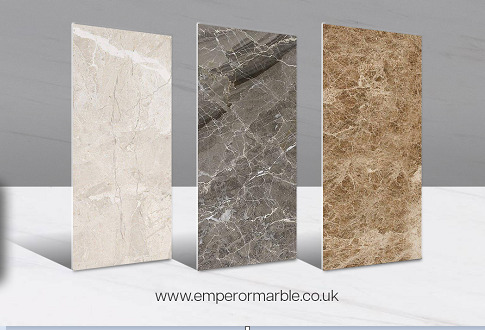
Marble stone suppliers distinguish themselves through a deep knowledge of the geological nuances that shape each slab. They understand the unique veining, color variations, and structural integrity of different marble varieties. This expertise allows them to guide customers in selecting the perfect marble for their specific design vision, ensuring that every installation becomes a harmonious blend of aesthetics and functionality.
Customization as an Art Form
Exceptional marble supplier recognize that each project is a unique canvas waiting to be adorned. They offer customization options that go beyond the conventional, allowing clients to shape and mold the marble to suit their distinct preferences. From bespoke cuts and finishes to intricate inlays and patterns, these suppliers transform marble into a personalized masterpiece, reflecting the individuality of each space.
A hallmark of a reputable marble supplier is transparent communication and a commitment to educating customers. The best suppliers demystify the complexities of marble selection, offering guidance on factors such as durability, maintenance, and suitability for different applications. This transparent approach builds trust and empowers clients to make informed decisions about their marble investments.
Marble stone suppliers are the unsung heroes behind the scenes, transforming spaces into showcases of timeless beauty. Their craftsmanship, ethical sourcing practices, expertise, and commitment to excellence elevate the experience of incorporating marble into any project. As you embark on the journey of adorning your space with the elegance of marble, remember that choosing the right marble supplier is not just a transaction; it's an investment in the artistry that turns stone into a masterpiece.
#Commercial Space Floor Tiles#Buy marble tiles online#polished marble mosaic tiles#Marble stone suppliers
0 notes
Text
TYPES OF SURFACE DESIGN IN 2024 WORLD

Surface design refers to the application of decorative elements to the surface of a material, enhancing its visual appeal and texture. There are various types of surface design techniques, each with its unique methods and applications. Here are some common types of surface design:
Write FAQs Based On Surface Design
Textile Surface Design:
- Printing: Techniques such as screen printing, block printing, digital printing, and heat transfer can be used to apply patterns and designs onto fabrics.
- Dyeing: Various dyeing methods, including tie-dye, batik, shibori, and dip-dyeing, can be employed to add color and patterns to textiles.
- Embroidery: This involves embellishing fabric surfaces with stitched designs using threads, beads, or other materials.
Graphic Design:
- Digital Graphics: Computer-aided design (CAD) software is used to create digital graphics for surfaces, such as wallpapers, digital prints on textiles, and other decorative applications.
- Decals and Transfers: Applying pre-designed decals or transfers onto surfaces, including ceramics, glass, and metals.
Wall Surface Design:
- Wallpaper: Traditional or digital wallpapers come in various patterns, textures, and colors to enhance the aesthetic appeal of walls.
- Wall Murals: Large-scale, hand-painted or digitally printed murals can transform a wall into a work of art.
- Ceramic Surface Design:
- Glazing: The application of glazes to ceramics before firing, with techniques like dipping, brushing, and spraying, to achieve different surface finishes.
- Sgraffito: Scratching through layers of slip or glaze to reveal contrasting colors or the underlying surface.
Wood Surface Design:
- Wood Carving: Intricate designs can be carved into wood surfaces, creating texture and patterns.
- Inlay and Marquetry: Adding decorative elements by embedding contrasting materials into the surface of the wood.
Metal Surface Design:
- Etching: Using chemicals or tools to create patterns or designs on the surface of metal.
- Patination: Treating metal surfaces with chemicals to induce color changes or textures.
- Paper Surface Design:
- Paper Cutting: Intricate designs are cut into paper to create patterns or images.
- Collage: Layering different paper elements to create visually interesting compositions.
- Concrete Surface Design:
- Stamped Concrete: Patterns are stamped onto freshly poured concrete to create textures and designs.
- Staining: Applying color stains to concrete surfaces to achieve different hues and effects.
- Leather Surface Design:
- Embossing: Creating raised patterns or designs on leather by pressing or stamping.
- Tooling: Using specialized tools to carve intricate designs into the surface of leather.
- Glass Surface Design:
- Etching: Similar to metal etching, chemicals or abrasive techniques are used to create frosted or patterned designs on glass surfaces.
- Fused Glass: Layering and fusing different pieces of colored glass to create unique patterns and textures.
- Plastic Surface Design:
- Molding: Creating textured or patterned surfaces during the molding process for plastic products.
- Film Application: Applying decorative films or laminates to plastic surfaces for added visual appeal.
- Floor Surface Design:
- Floor Inlays: Integrating different materials, such as wood or tile, into flooring to create decorative patterns.
- Stenciling: Applying paint or other materials through stencils to create patterns on floors.
- Digital Surface Design:
- Generative Design: Using algorithms and computer programs to create intricate and often complex designs.
- Augmented Reality (AR) Surfaces: Interactive digital elements overlaid on physical surfaces, often used for immersive experiences.
- Stone Surface Design:
- Engraving: Carving designs or patterns into stone surfaces using tools or abrasive techniques.
- Polishing: Enhancing the natural patterns and colors of stones through polishing processes.
- Mixed Media Surface Design:
- Combining multiple materials: Using a combination of materials like fabric, paper, metal, and others to create eclectic and textured surfaces.
- Assemblage: Creating surfaces by assembling various objects and materials into a cohesive design.
- Bio-Fabrication Surface Design:
- Living Surfaces: Incorporating living organisms like moss or algae into design elements for sustainable and eco-friendly surface treatments.
- Biodegradable Materials: Using materials that decompose naturally over time, contributing to environmental sustainability.
- Digital Fabrication and 3D Printing:
- Additive Manufacturing: Creating intricate surface designs layer by layer using 3D printing or other digital fabrication techniques.
- Parametric Design: Utilizing algorithms to generate designs with variable parameters, resulting in complex and customizable surface patterns.
- Concrete Stenciling:
- Using stencils to apply patterns, images, or textures onto concrete surfaces, often seen in outdoor spaces like patios and sidewalks.
- Digital Embroidery:
- Employing computerized embroidery machines to create intricate and detailed designs on fabric, allowing for precise and complex patterns.
- Laser Cutting:
- Using laser technology to cut or engrave intricate patterns onto various materials such as wood, acrylic, fabric, and leather.
- Bamboo Surface Design:
- Utilizing the natural characteristics of bamboo, such as its grain and texture, to create decorative patterns through methods like burning, carving, or staining.
- Metal Leafing:
- Applying thin sheets of metal (such as gold leaf or silver leaf) onto surfaces for a luxurious and reflective finish.
- Digital Projection Mapping:
- Projecting dynamic digital images onto surfaces to create immersive and interactive experiences, often used in art installations and events.
- Tyvek Art:
- Exploring surface design using Tyvek, a synthetic material known for its durability, through techniques like folding, cutting, and heat manipulation.
- Sandblasting:
- Using abrasive materials propelled at high speed to etch or texture surfaces, commonly applied to glass, stone, or metal.
- Tape Art:
- Creating intricate designs by applying colored tapes directly onto surfaces, allowing for temporary and dynamic visual enhancements.
- Hydro Dipping (Water Transfer Printing):
- Submerging objects into a water bath with a floating layer of printed designs, enabling the transfer of the design onto the surface of the object.
- Resin Art:
- Using epoxy resin to create glossy and three-dimensional surfaces with embedded pigments, objects, or textures.
- Natural Surface Design:
- Incorporating elements from nature, such as leaves, flowers, or bark, directly onto surfaces through techniques like eco-printing or botanical printing.
- Digital Wallcoverings:
- Customizing and printing large-scale wallcoverings digitally, allowing for intricate patterns, high-resolution images, and unique designs.
- Bio-Mimicry Surface Design:
- Drawing inspiration from nature to create designs that imitate natural patterns, textures, or organic structures.
- Smart Surfaces:
- Integrating technology into surfaces to create "smart" features, such as responsive lighting, interactive displays, or surfaces that change color or texture based on external stimuli.
- Flocking:
- Applying small fiber particles (flock) to adhesive-coated surfaces, creating a velvety or textured finish. This technique is often used on fabrics, paper, or even plastic.
- Concrete Acid Staining:
- Using acid-based chemicals to react with the minerals in concrete, resulting in unique and variegated colors on the surface.
- CNC Routing:
- Employing computer numerical control (CNC) machines to precisely cut, carve, or engrave intricate patterns into various materials like wood, plastic, or metal.
- Kinetic Surfaces:
- Designing surfaces that can move or change dynamically, creating kinetic art installations or functional elements with changing patterns.
- Photomontage and Collage:
- Creating visual compositions by combining photographs or cutouts from various sources to form a cohesive design on surfaces like paper or canvas.
- Carbon Fiber Weaving:
- Utilizing the weaving technique with carbon fiber materials to create lightweight and strong surfaces, often used in high-performance applications.
- Cork Surface Design:
- Using cork as a material for surface treatments, which can include printing, staining, or shaping to enhance its natural characteristics.
- UV Printing:
- Employing ultraviolet (UV) light to cure or dry inks on surfaces quickly, allowing for vibrant and durable prints on various materials.
- Marbling:
- Floating and manipulating pigments on the surface of a liquid bath before transferring the design onto paper, fabric, or other materials.
- Smoke Firing (Raku Pottery):
- Exposing pottery to smoke during the firing process, creating unique and unpredictable surface patterns through the interaction of smoke and clay.
- Capiz Shell Inlay:
- Incorporating thin, translucent shells from the windowpane oyster (Capiz) into surfaces, often used in decorative items and furniture.
- Spray Painting:
- Applying paint using aerosol spray cans, allowing for a quick and even distribution of color on surfaces like walls, canvases, or objects.
- String Art:
- Creating geometric or abstract designs by arranging and affixing threads or strings to a surface, often in conjunction with nails or pins.
- Magnetic Surfaces:
- Integrating magnetic materials into surfaces, allowing for the attachment of magnetic elements or interactive features.
- Solar Printing:
- Using sunlight to create photographic prints on surfaces coated with light-sensitive materials, often resulting in cyanotype or sun print designs.
- Thermal Printing:
- Applying heat to special paper or materials to produce images or patterns, commonly used in receipt printers and certain art applications.
- Velvet Finishes:
- Achieving a soft and plush texture on surfaces through techniques like velvet flocking, fabric application, or specialized finishes.
- Mirror Mosaics:
- Creating intricate patterns by arranging small mirror pieces to form a mosaic on surfaces, adding reflective and dynamic qualities.
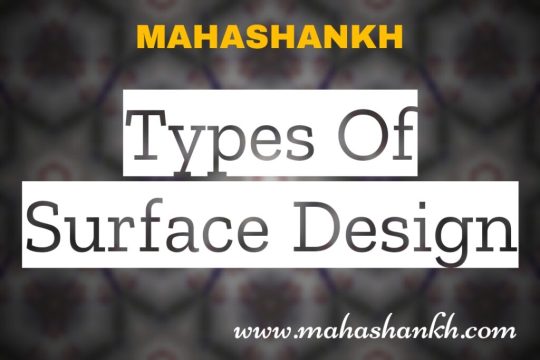
TYPES OF SURFACE DESIGN
Write FAQs Based On Surface Design
What is surface design?Surface design involves enhancing the appearance and texture of various materials through decorative techniques and artistic applications.What are some common materials used in surface design?Common materials include textiles, paper, wood, metal, glass, ceramics, concrete, plastic, and more.How is digital surface design different from traditional methods?Digital surface design involves using computer-aided tools and technologies, while traditional methods rely on manual techniques like printing, painting, and carving.Can surface design be applied to 3D objects?Yes, surface design can be applied to 3D objects through techniques like painting, carving, and various coatings.What is the significance of texture in surface design?Texture adds tactile and visual interest to surfaces, creating a unique and dynamic user experience.How does one get started with textile surface design?Getting started involves learning techniques like printing, dyeing, and embroidery, often through courses, workshops, or self-study.What is the difference between surface design and interior design?Surface design focuses on enhancing the appearance of materials, while interior design encompasses overall spatial planning and aesthetics.Can surface design be applied to outdoor spaces?Yes, surface design can be applied outdoors through techniques like concrete stenciling, murals, and landscaping.What is the role of color theory in surface design?Color theory guides the selection and combination of colors, influencing the visual impact and emotional response to surface designs.Are there sustainable surface design practices?Yes, sustainable practices include using eco-friendly materials, minimizing waste, and considering the life cycle of products.What is the difference between patination and oxidation in metal surface design?Patination is a controlled process to achieve specific colors, while oxidation refers to the natural corrosion of metal over time.Can surface design be applied to digital interfaces?
Yes, digital surface design is relevant in creating user interfaces, websites, and applications, focusing on visual elements and user experience.How is bio-mimicry used in surface design?Bio-mimicry involves imitating natural patterns and forms, bringing elements from nature into surface design for aesthetic and functional purposes.What tools are commonly used in wood surface design?Tools include carving tools, sandpaper, stains, and finishes for techniques like carving, inlay, and wood burning.What is the purpose of surface design in packaging?Surface design on packaging enhances product visibility, communicates brand identity, and attracts consumer attention.Can surface design be used for creating custom wallpapers?Yes, surface design plays a crucial role in creating unique and customized wallpapers with various patterns and textures.How does one create a seamless pattern in surface design?Seamless patterns are created by ensuring that the edges of the design align seamlessly when repeated, often using digital tools.What is the role of lighting in showcasing surface design?Lighting enhances the visibility and appreciation of surface design details, emphasizing textures, colors, and patterns.Is 3D printing used in surface design?Yes, 3D printing can be employed to create intricate and three-dimensional surface designs on various materials.What are the different types of embroidery stitches used in textile surface design?Common stitches include satin stitch, chain stitch, and French knots, each contributing to different textures and patterns.How can surfaces be designed for acoustics in interior spaces?Materials with specific textures and compositions can be chosen to absorb or diffuse sound, contributing to better acoustics.What is the role of CNC routing in surface design?CNC routing enables precise cutting and carving of intricate patterns on materials like wood, plastic, and metal.Can surface design impact a brand's identity?Yes, surface design on products, packaging, and marketing materials can significantly influence and reinforce a brand's identity.What is the significance of negative space in surface design?Negative space, or empty areas, is essential for creating balance and visual interest in surface designs.How does one create a distressed or aged look in surface design?Techniques such as sanding, distressing, and applying specific finishes can give surfaces an aged or weathered appearance.Can surface design be temporary or removable?Yes, techniques like decals, removable wallpapers, and temporary coatings allow for surface designs that can be changed or removed easily.What role does psychology play in color selection for surface design?Colors can evoke specific emotions and responses, making color psychology crucial in selecting hues for surface designs.How can one protect surface designs from wear and tear?Protective coatings, sealants, and proper maintenance help preserve surface designs and extend their lifespan.What is the difference between hand-painted and digitally printed surface designs?Hand-painted designs involve manual application, while digital printing allows for precise and replicable designs using technology.Can surface design be used in landscape architecture?Yes, surface design principles are applied in landscaping through features like patterned pavements, murals, and artistic installations.What is the role of cultural influences in surface design?Cultural influences impact design aesthetics, motifs, and color choices, adding richness and diversity to surface design.Can surface design be used to create tactile maps for the visually impaired?Yes, tactile maps with raised surfaces and textures can be designed to provide spatial information for the visually impaired.How does one create a harmonious color palette in surface design?Harmonious color palettes are achieved by selecting colors that complement each other, often using color wheels and schemes as guides.Is surface design used in automotive interiors?
Yes, surface design is applied in automotive interiors through materials, textures, and finishes to enhance the overall aesthetic.What is the difference between matte and glossy finishes in surface design?
Matte finishes have a non-reflective surface, while glossy finishes are reflective, creating different visual effects and tactile sensations.How does one incorporate lighting effects in surface design?
Integrated lighting, backlighting, and reflective materials can be used to create dynamic and visually striking effects on surfaces.Can surface design be used in product prototyping?Yes, surface design is often incorporated into product prototypes to visualize and refine the final appearance.
Read the full article
#Abstractsurfacedesign#Colorexploration#Contemporarypatterns#Digitalsurfacedesign#Fabricmanipulation#Floralmotifs#GeometricPatterns#Hand-drawnmotifs#Mixedmediasurfaces#Organictextures#Patterncreation#Patterndesigninspiration#Printmaking#Repeatpatterntechniques#Repeatpatterns#Surfacepatternillustration#Sustainablesurfacedesign#Textileart#Textilesurfacedesign#urfacedesign#Vintagesurfacedesign
0 notes
Text










CD-/DVD-labels - Trykkeriet Vårt - 984 02 480 / [email protected] / www.bss-mr.no
Vi tilbyr ei brei rekke av trykketenester for CD-ar og DVD-ar, inkludert booklets, sleeves, etikettar og inlays. For å gjere det enklare for deg, har vi òg nedlastbare maler tilgjengelege som du kan tilpasse for designet til produktet ditt. Om du ikkje er så flink med grafisk design, kan vi hjelpe deg med å finne ein erfaren designer eller gi deg eit uforpliktande tilbod frå designavdelinga vår via e-post.
Brukerstyrt senter Møre og Romsdal / Trykkeriet Vårt
E-post: [email protected]
Telefon: 984 02 480
Adresse: Grandfjæra 28, 6415 Molde (Vi held til i Molde Mølle, du finn oss i underetasjen - Stikk gjerne innom!)
Støtt oss: Mental Helse Molde, Kavlifondet, Sparebanken Møre, Sparebank 1 SMN, Sunndal Sparebank, Bergesenstiftelsen, Gjensidigestiftelsen, MFKs - Prosjekt Tilhørighet og Norsk Tippings - Grasrotandel
Ved BSS tilbyr vi eit spennande arbeidsmiljø og ein stad for å møtast. Det unike med oss er at vi er 100% brukarstyrt, frå botnen til toppen.
Støtt oss du òg! Alt går uavkorta til brukarane ved BSS, og arbeidet mot utanforskapet.
mentalhelsemolde
tonnyfroyen
cokemann
fineaiart
mobiltoner
moldesentrum
romsdalen
handlelokalt
moldekommune
rbnett
roseby
mynorway
norge
kortreist
lokalverdiskaping
nisjebutikk
brydeg
trykkeri
iogdu
moldetorget
nrkmogr
brukbyendin
handlelokaltmolde
omsorg
visitmolde
norway
psykiskhelse
aktivhverdag
godmorgennorge
jobb
#mentalhelsemolde#tonnyfroyen#cokemann#fineaiart#mobiltoner#moldesentrum#romsdalen#handlelokalt#moldekommune#rbnett#roseby#mynorway#norge#kortreist#lokalverdiskaping#nisjebutikk#brydeg#trykkeri#iogdu#moldetorget#nrkmogr#brukbyendin#handlelokaltmolde#omsorg#visitmolde#norway#psykiskhelse#aktivhverdag#godmorgennorge#jobb
0 notes
Text
Restoring Smiles: A Deep Dive into Dental Inlays in Westport

Dental Inlays westportIntroduction:
A confident smile is often a reflection of good oral health, and for residents of Westport, the availability of advanced dental procedures contributes to the restoration and enhancement of their smiles. One such procedure gaining prominence in the realm of restorative dentistry is dental inlays. In this comprehensive exploration, we will delve into the intricacies of dental inlays, their relevance in Westport, and the benefits they offer to individuals seeking to restore and preserve their smiles.
Understanding Dental Inlays:
Dental inlays are a form of indirect restoration used to repair moderately damaged or decayed teeth. Unlike dental fillings that are molded directly into the tooth during the dental visit, inlays are fabricated in a dental laboratory based on impressions taken during the initial consultation. Typically crafted from materials like porcelain or composite resin, these custom-made inlays are then bonded to the prepared tooth during a subsequent appointment.
The Dental Inlay Procedure:
Assessment and Preparation:
The process begins with a thorough assessment of the tooth's condition. If a dental inlay is deemed appropriate, the tooth is prepared by removing the decayed or damaged portion, and an impression is taken.
Temporary Restoration:
While the permanent inlay is being crafted, a temporary restoration may be placed to protect the tooth. This ensures that the tooth remains functional and aesthetically pleasing during the fabrication period.
Custom Fabrication:
The impressions are sent to a dental laboratory where skilled technicians create a custom-fit inlay. The material chosen for the inlay is durable, natural-looking, and compatible with the patient's bite.
Permanent Placement:
Once the inlay is ready, the temporary restoration is removed, and the permanent inlay is bonded to the tooth using dental cement. The dentist ensures proper fit, bite alignment, and aesthetics during this final placement.
Relevance of Dental Inlays in Westport:
In Westport, where residents appreciate both aesthetics and functionality, Dental Inlays in westport have become a popular choice for individuals seeking to restore and enhance their smiles. The coastal town's commitment to oral health is reflected in the availability of advanced restorative procedures, and dental inlays stand out as an effective and durable solution for addressing a range of dental issues.
Common Indications for Dental Inlays:
Moderate Tooth Decay:
Dental inlays are particularly suitable for cases of moderate tooth decay where a traditional filling may not provide sufficient strength and support.
Fractured or Damaged Teeth:
Inlays are an excellent option for restoring teeth with fractures or other forms of damage, offering durability and a natural appearance.
Large or Defective Fillings:
When existing fillings become large or defective, inlays provide a more stable and aesthetically pleasing alternative for reinforcing the tooth structure.
Preservation of Healthy Tooth Structure:
Dental inlays allow for the preservation of healthy tooth structure, as they are custom-fitted and designed to match the natural contours of the tooth.
Benefits of Dental Inlays in Westport:
Aesthetics and Natural Appearance:
Dental inlays, often made from tooth-colored materials like porcelain, seamlessly blend with natural teeth. This aesthetic advantage makes them an ideal choice for individuals in Westport who prioritize a natural-looking smile.
Durability and Longevity:
Dental inlays are known for their durability and longevity. Crafted from strong materials, they can withstand the forces of biting and chewing, providing lasting support to the treated tooth.
Conservative Restoration:
Unlike dental crowns, which require more extensive tooth preparation, inlays allow for a more conservative restoration. They preserve more of the natural tooth structure while still providing effective repair.
Customization for Optimal Fit:
Each dental inlay is custom-crafted to fit the specific contours of the patient's tooth. This level of customization ensures an optimal fit, contributing to both comfort and functionality.
Minimized Tooth Sensitivity:
Dental inlays, by virtue of their precise fit and bonding, can contribute to minimizing tooth sensitivity. They provide a protective barrier against temperature changes and other external stimuli.
Conclusion:
In conclusion, dental inlays emerge as a valuable and effective solution for individuals in Westport seeking to restore and preserve their smiles. The combination of aesthetics, durability, and a conservative approach makes dental inlays a popular choice for those dealing with moderate tooth decay, damage, or the need to replace defective fillings. As Westport residents consider options for enhancing their oral health and revitalizing their smiles, the availability and benefits of dental inlays play a pivotal role in contributing to a community adorned with confidently restored grins.
0 notes
Text

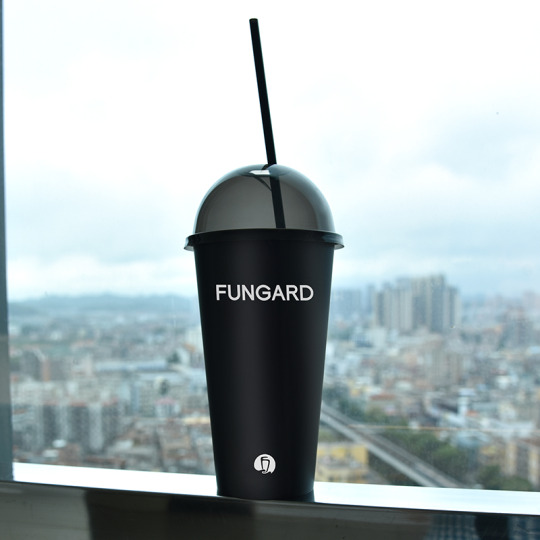



Because the iml film in mould label process can better display diversified and personalized designs on milk tea cups, it can push the boba tea brand to a higher level. The IML in mould label process is an innovative injection molding and printing technology. It prints colorful and complex patterns on film, then composites multiple layers of film with different materials, and finally places it in the injection molding machine and on the boba tea cup. The one-piece molding not only increases the beauty of the boba tea cup, but also enhances the brand's image and value. The following are several significant advantages brought to boba tea brands by the IML in-membrane pasting process.
First of all, the iml film in mould label process can realize personalized boba tea cup customization. Traditional printing processes can often only print simple patterns or text on the surface of boba tea cups, which is difficult to meet consumers' needs for personalized designs. The IML film in mould label pasting process can completely present colorful patterns inside the boba tea cup, making the boba tea cup a mobile advertisement for the brand and attracting customers' attention. Whether it is a unique brand logo, exquisite illustrations or creative text, it can all be realized through the IML film in mould label process, making the boba tea brand stand out in the market.
Secondly, the iml film in mould label sticking process can improve the quality of the boba tea brand. Good products require good packaging. The iml film inner pasting process brings more different appearance materials to bubble tea cups, metal film, silver effect, gold effect, copper effect and more higher texture and added value. Through the IML film inlay process, the appearance of the bubble tea cup becomes more refined, the touch is more delicate, and the surface finish is also greatly improved. This high-quality packaging design will undoubtedly increase consumers' trust in the bubble tea brand, making them more willing to choose products that are consistent with the brand image.
Finally, the iml film inlay process also has good durability and anti-counterfeiting properties. The bubble tea cup made with IML film inlay technology, the pattern is integrated with the cup body, it will not fall off or discolor even if used for a long time, and maintains good appearance and hygienic condition. At the same time, the IML in mould label process can also be combined with anti-counterfeiting technology to increase the anti-counterfeiting function of the product and protect the intellectual property rights and market share of the bubble tea brand.
To sum up, the IML in-membrane pasting process brings many advantages to bubble tea brands. It can achieve personalized customization, enhance brand image and quality, and enhance product durability and anti-counterfeiting. This innovative decal technology gives bubble tea brands a greater competitive advantage and helps them stand out in the fierce market competition. Therefore, bubble tea brands should actively adopt the IML film in mould label sticking process to present consumers with a richer and more personalized product experience.
0 notes
Text
Wooden Photo Frame Design
Designing a wooden photo frame can be a fun and creative project. Wooden frames offer a classic and timeless look, and you can customize them to match your style and the photos they will hold. Here are some wooden photo frame design ideas and tips to consider:
Selecting the Wood:
Choose the type of wood you want for your frame. Common choices include oak, walnut, cherry, pine, and maple. Each wood type has its unique color and grain pattern.
Frame Style:
Decide on the style of your frame. Some popular options include:
Classic: Simple, clean lines with a plain or beveled edge.
Rustic: Weathered or distressed wood with a rougher texture.
Ornate: Elaborate carvings, moldings, or decorative elements.
Contemporary: Sleek and minimalist with clean angles and edges.
Size and Dimensions:
Determine the size of your photo frame based on the dimensions of the photo you want to display. Standard photo sizes include 4×6, 5×7, and 8×10 inches, but you can make frames for custom sizes as well.
Mitered Corners:
If you’re making a rectangular or square frame, consider mitering the corners for a seamless look. This involves cutting the frame pieces at 45-degree angles and joining them at the corners.
Paint or Stain:
Decide whether you want to paint the frame, stain it, or leave it natural. Staining can enhance the wood’s grain, while painting allows for a wide range of color options.
Decorative Elements:
Add decorative elements like wood carvings, inlays, or appliqués to enhance the frame’s visual appeal. These can be customized to suit your style and preferences.
Matting:
If you’re framing a photo or artwork, consider using a mat (usually made of paper or fabric) to create a border around the image. Mats can add a touch of elegance and professionalism to your frame.
Glass or Acrylic:
Decide whether you want to include glass or acrylic to protect the photo. Glass provides a traditional look, while acrylic is lighter and less likely to break.
Backing and Hardware:
Include a sturdy backing board (usually made of cardboard or foam core) to hold the photo in place. Attach a hanging hook or wire to the back for wall mounting, or add a stand for tabletop display.
Personalization:
Consider personalizing the frame with initials, a date, or a meaningful quote using woodburning, engraving, or paint.
Texture and Finish:
Experiment with different textures, such as distressing the wood or using wood filler to create a textured surface. Finish with varnish or clear coat for protection and shine.
Multi-Photo Collage:
Create a collage frame with multiple openings for different photos. This can be a great way to display a series of related images.
Vintage or Antique Look:
Distress the wood, apply an antiquing glaze, or use crackle paint to give your frame a vintage or aged appearance.
Remember to measure and cut the wood accurately, use appropriate safety gear and tools, and take your time to ensure a high-quality finished product. Whether you’re making a frame for a cherished family photo or as a gift for someone special, a well-designed wooden photo frame can be a beautiful addition to any home.
For more information visit us our website : http://rangwooden.com/
0 notes
Text
Touchstone Forte Electric Fireplace on HGTV
Focus on the Touchstone Forte Electric Fireplace -- The traditionally sized Touchstone Forte Electric Fireplace is featured in two dream homes on Season 4 of HGTV’s 100 Day Dream Home. In Episode 9 "Plants in Plant City," homeowners Alex and Raelynn yearn for a spacious modern farmhouse with an open concept layout.
Touchstone Forte Electric Fireplace, photo credits: Grace Customs and HGTV 100 Day Dream Home
Raelynn wants an electric fireplace and looks forward to hanging stockings at Christmas. Alex loves herringbone and wants that design element in the new home. The 100 Day Dream Home crew delivers on both must-haves with a custom herringbone fireplace accent wall featuring the Touchstone Forte Electric Fireplace. Mika notes the herringbone elevates the design aesthetic and draws attention to movement.
READ MORE: https://bit.ly/45noI2O
About HGTV 100 Day Dream Home -- Tune into HGTV’s 100 Day Dream Home for more beautiful custom home creations and style inspiration from partners Mika and Brian Kleinschmidt (pictured at top). Watch on HGTV and stream anytime on Discovery+. Follow Brian and Mika on Instagram @mrbreakinground @dirt2designllc@hgtv
About Grace Customs -- Grace Customs installs all types of trim, crown molding, shiplap, wainscoting, accent walls, ceiling beams, ceiling inlays, coffered ceilings, custom built-ins, and fireplaces in the Tampa, Florida area. Follow them on Instagram and Facebook @gracecustoms913

#home decor#electric fireplace#home & lifestyle#interiors#interior decorating#fireplaces#home builders#interior designers#touchstone fireplaces#diy projects#hgtv#100 day dream home
0 notes
Text
Antique Furniture Restoration: Areas of Special Attention
Antique furniture carries with it the weight of history, whispers of stories from the past, and a unique charm that modern furniture often lacks. When restoring such pieces, one must not only think of aesthetics but also of preserving the very essence of the item. Here's a closer look at the critical areas to pay special attention to when diving into the art and science of antique furniture restoration.
Research and Authenticity
Before sanding, repainting, or making any changes, it's crucial to do your homework. Sometimes, the blemishes and wear are what give a piece its value. Look for markings, tags, or any other indicators of its origin. Researching the period, style, and manufacturer can give you valuable information on the materials and techniques originally used, ensuring your restoration efforts are in line with the piece's historical context.
Structural Integrity
Antique furniture restoration isn't just about aesthetics. The piece needs to be functional and safe. Examine the joints, legs, and other load-bearing components to ensure they can still bear weight. Loose or wobbly parts might need regluing or reattachment. Traditional joinery techniques, like dovetailing, should be maintained wherever possible.
Veneer and Inlay Work
Veneering is a common technique in antique furniture, where thin layers of high-quality wood are bonded to a base of lesser quality wood. This veneer can become loose, chipped, or damaged over time. Similarly, inlaid designs, which are made by embedding pieces of contrasting materials into the surface of furniture, can also suffer damage. Both require delicate work to restore without causing further damage, so be prepared to use patience and precision when handling these areas.
Hardware and Fittings
Antique furniture often comes with original hardware like handles, knobs, locks, and hinges. These pieces not only serve a functional purpose but add to the character of the item. Whenever possible, restore and reuse the original hardware. If replacements are necessary, source replicas or period-appropriate pieces to maintain authenticity.
Finish and Patina
The finish of a piece of furniture – be it varnish, shellac, or oil – protects the wood and enhances its appearance. Over time, this finish can degrade. However, rather than just stripping and refinishing, consider the patina – the natural aging process of wood that gives it a distinct, often valued, character. Stripping can remove this patina, so it's essential to weigh the benefits of a new finish against the loss of historical character.
Upholstery and Fabric
If the antique has an upholstered component, this area can often show the most wear. The temptation might be to replace old, worn-out fabric with something new and vibrant, but consider the historical accuracy. If the original fabric is salvageable, professional cleaning or minor mending might be preferable. If reupholstery is the only option, try to choose fabrics that reflect the period and style of the piece.
Pests and Mold
Antiques, especially those kept in damp or dark conditions, can become home to pests like woodworms or mold. Address these issues immediately. Treatment for woodworms might involve chemical applications or controlled freezing, depending on the infestation's severity. Mold, on the other hand, requires cleaning with appropriate solutions and ensuring the piece is kept in a dry, well-ventilated area afterward.
Tools and Techniques
Using the right tools and techniques can make all the difference. Where possible, use hand tools to maintain control and reduce the risk of damaging the piece. Familiarize yourself with traditional techniques used during the piece's era. Sometimes, the old ways are the best ways when it comes to restoration.
Conclusion
Antique furniture restoration is a journey of patience, respect, and love for history. By paying special attention to these areas, not only can the physical beauty of the piece be rejuvenated, but its soul and story can continue to inspire and enchant for generations to come. Remember, it's not about making the piece look new, but about honoring its past while ensuring its future.
0 notes
Text
Investigating the Three Types of Carpenters
Carpentry is a centuries-old trade that marries craftsmanship, precision, and creativity. Carpenters have been instrumental in building structures, crafting furniture, and bringing architectural visions to life. Within this diverse field, there are three distinct types of carpenters, each specializing in unique areas of expertise. In this article, we will delve into the world of carpentry and explore the fascinating specialties of rough carpenters, finish carpenters, and cabinetmakers.
Rough Carpenters:
Rough carpenters, often referred to as framing carpenters, are the backbone of any construction project. They lay the foundation and build the structural framework of a building. These skilled craftsmen work with precision, employing their expertise to read and interpret blueprints and transform them into tangible structures.
Rough carpenters are responsible for tasks such as framing walls, roofs, and floors, as well as constructing scaffolding and formwork. They work with an array of tools, including saws, hammers, levels, and power tools, to make precise cuts, shape wooden components, and ensure proper alignment. Their work is crucial in creating a sturdy and stable structure that adheres to building codes and regulations.
Finish Carpenters:
Finish carpenters are the artists of the carpentry trade, focusing on the final stages of a construction project. They bring finesse and aesthetic appeal to a structure, ensuring that it is not only functional but visually pleasing as well. Finish carpenters excel in the installation of doors, windows, trim, moldings, and other decorative elements.
These skilled craftsmen possess a keen eye for detail, meticulously fitting each piece to ensure seamless alignment and impeccable craftsmanship. Finish carpenters work with various materials, including wood, composite materials, and even metal, using specialized tools such as miter saws, chisels, routers, and sanders. They are skilled in creating intricate joinery, such as dovetail and mortise-and-tenon joints, which adds strength and character to their work.
Beyond the structural aspects, finish carpenters also focus on surface finishes, applying paints, stains, and varnishes to achieve the desired appearance. They possess a deep understanding of design principles and collaborate closely with architects and interior designers to bring their vision to life. Their expertise elevates the overall aesthetic value of a structure, creating a visually appealing and inviting space.
Cabinetmakers:
Cabinetmakers specialize in the art of creating custom cabinetry and furniture. They combine functionality with artistic expression to design and construct unique pieces tailored to individual needs and preferences. Cabinetmakers possess an in-depth knowledge of different wood types, joinery techniques, and finishing methods.
These highly skilled craftsmen work closely with clients, architects, and designers to translate ideas into tangible, one-of-a-kind pieces. From kitchen cabinets and bathroom vanities to elegant furniture pieces, cabinetmakers bring their artistic vision to fruition. They employ a wide range of tools, including routers, table saws, planers, and sanders, to shape, join, and finish wood. Their craftsmanship extends beyond carpentry, encompassing skills in design, woodworking, and even decorative elements such as carving and inlay work.
Carpentry is a versatile and intricate trade that encompasses various specialties. Rough carpenters lay the foundation and structural framework, ensuring the solidity of a building. Finish carpenters add the finishing touches and aesthetic appeal, creating visually stunning spaces. Cabinetmakers bring artistic expression and craftsmanship to their creations, crafting bespoke pieces that blend functionality with personalized style.
0 notes